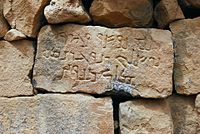Nabataean Arabic
| Nabataean Arabic | |
|---|---|
 |
|
| Region | Northwestern Arabian Peninsula and the southern Levant |
| Era | 4th century BCE to 1st century CE |
|
Afroasiatic
|
|
| Nabataean | |
| Language codes | |
| ISO 639-3 |
None (mis) |
| Glottolog | None |
Nabataean Arabic was the dialect of Arabic spoken by the Nabataeans in antiquity. In the 1st century AD, the Nabataeans wrote their inscriptions, such as the legal texts carved on the façades of the monumental tombs at Madāʾin Ṣāliḥ, ancient Ḥegrā, in the Aramaic language. It is probable, however, that some or all of them, possibly in varying proportion depending on the region of the Nabataean Kingdom where they lived, spoke Arabic.
In contrast with Old Higazi and Classical Arabic, Nabataean Arabic may have undergone the shift [e] < *[i] and [o] < *[u], as evidenced by the numerous Greek transcriptions of Arabic from the area. This may have occurred in Safaitic as well, making it a possible Northern Old Arabic isogloss.
Proto-Arabic nouns could take one of the five above declensions in their basic, unbound form.
The definite article spread areally among the Central Semitic languages and it would seem that Proto-Arabic lacked any overt marking of definiteness.
The ʿEn ʿAvdat inscription in the Nabataean script dating to no later than 150 shows that final [n] had been deleted in undetermined triptotes, and that the final short vowels of the determined state were intact. The reconstructed text of the inscription is as follows:
The Old Arabic of the Nabataean inscriptions exhibits almost exclusively the form ʾl- of the definite article. Unlike the Classical Arabic article, the Old Arabic ʾl almost never exhibits the assimilation of the coda to the coronals.
...
Wikipedia
